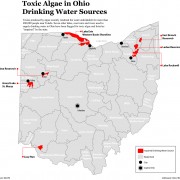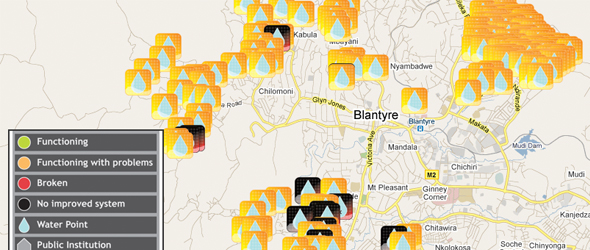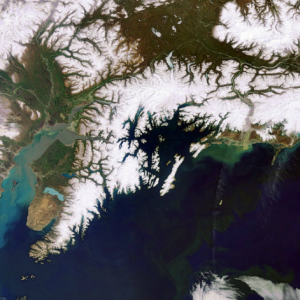Peter Gleick: World Water Day 2010 — A trip through one of the worst slums in the world
Like urban slums throughout the developing world, there is almost a complete lack of piped safe water and no formal sanitation. Raw sewage and garbage flow through the streets and drainage ditches.
Happy World Water Day, readers. March 22 is always reserved for this event, and this year, I’m in Nairobi, Kenya where the Pacific Institute is working with the United Nations Environment Programme to help raise awareness about this year’s special focus: Water quality.
I spent part of today walking through Kibera’s Soweto East Village in Nairobi — considered to be the world’s second largest urban slum. There are no official population figures, but Kibera is thought to be home to as many as a million people: 25 percent of Nairobi’s population, on one percent of the land. (Wikipedia has a pretty good entry on Kibera, for those wanting more.)
And like urban slums throughout the developing world, there is almost a complete lack of piped safe water and no formal sanitation. As the pictures below show, raw sewage and garbage flow through the streets and drainage ditches. I’ve traveled a lot. I’ve seen some of the poorest parts of the world, but even for me, what I saw today was a shocking reminder of the wretched conditions that literally billions of people face. It was perhaps no coincidence that the first commercial business you see on the way into Kibera is a coffin maker, nor that many of his coffins are for children.
While there, I visited one of seven facilities that have been built in East Soweto Village to provide safe sanitation services. Managed by the local community, and built with the help of UN agencies like UN-Habitat, it has perhaps 8 pit toilets and a couple of shower stalls. People must pay to use them — 3 Kenya shillings (around 4 cents US). And despite the fact that these people have practically no money, as many as 1500 people a day line up to use this toilet block. The money goes to pay people to work there, to pay for the piped water (purchased from the local Council), and to buy toilet paper.
There are solutions to our water problems — these kinds of community-managed facilities are one. But these seven toilet blocks serve, minimally, perhaps 1 percent of the entire population of Kibera. The level of effort and resources being spent on water and sanitation solutions is woefully inadequate to the task.
Water Number: 2.6 billion people. In a new report released this week by WHO/UNICEF’s Joint Monitoring Programme, it is estimated that 2.6 billion people still lack access to adequate sanitation services and 1.1 billion must still practice “open defecation” (a polite term for a demeaning practice), like those in Kibera. This number is virtually unchanged from past assessments as population growth continues to overwhelm efforts to provide services.
On this World Water Day, be thankful for what most of us have: safe, reliable, and affordable clean water and sanitation. And consider doing something for those who don’t. Support any number of groups that work on these issues with time or money (the UN, Rotary, Water for People, World Vision, water.org, WaterAid, Global Water Challenge, and many, many more). Urge USAID to expand, dramatically, its African aid efforts for water and sanitation. Perhaps readers have other suggestions for positive actions that can be taken: add them as comments.
Peter Gleick
Dr. Gleick’s blog posts are provided in cooperation with the SFGate. Previous posts can be found here.










Hello Peter,
I am in Sao Paulo for a big World Water Day event sponsored by the private sector, trying to give back through corporate social responsibility. It will be interesting to see whether it raises awareness and/or generates funds for water projects.
One thing I found interesting in the new JMP report is that the 10 countries who had the most success in expanding access to water and sanitation from 1990 to 2008 were: China, India, Indonesia, Brazil, Pakistan, Vietnam, Bangladesh, Mexico, Egypt and the Philippines. Most of them were in the same order for providing access to sanitation and for water for all ten, except Brazil, which did better in sanitation than water. The sad part is that China and India, which expanded access to drinking water to more than 400 million people each, were only able to expand access to sanitation to something like half of that. Other than China and India, the other eight countries were expanding sanitation at about the same rate as water supply. We should encourage governments and the private sector to match the efforts to expand water with simultaneous efforts for sanitation.
I would also like to support Peter’s suggestions of agencies or groups to work with, and would add specifically the Water and Sanitation Collaborative Council and its WASH in Schools campaign with UNICEF (www.wsscc.org) and the Gender and Water Alliance (www.genderandwater.org).
Keep up the great work, Peter!
Regards, Marcia
Dear Dr. Gleick,
My name is Giselle Janke and I am completing a research project for my Senior English class at Jesuit High School in Portland, OR. Part of the project requirement is to interview an expert on my topic. I have chosen to research the selling of international water rights and I thought you would be an excellent source. As I was reading your report, I couldn’t help but think if the slum you visited was suffering as a result of having their countries’ water rights sold. And if this was true, were those supplies of water being used in another country that was less in need of that water?
I realize you are very busy, but if you would be able to answer about 5 questions via email, I would truly appreciate it. If you are willing to do this, I will send the questions to you in another email, and then follow up about a week later.
Thank you so very much for your time and for considering this!
Sincerely,
Giselle Janke
This is a gripping post and a sad story — but it also points to a positive path. Groups like Ecotact are bringing the “toilet mall” model to other African nations:
http://wateradvocates.wordpress.com/
Thanks for bringing attention to this critical topic.
Loggerhead Sea Turtle Anatomy